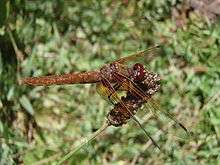Flame skimmer
| Flame skimmer | |
|---|---|
 | |
| Male Dragonfly | |
| Scientific classification | |
| Kingdom: | Animalia |
| Phylum: | Arthropoda |
| Class: | Insecta |
| Order: | Odonata |
| Suborder: | Anisoptera |
| Family: | Libellulidae |
| Genus: | Libellula |
| Species: | L. saturata |
| Binomial name | |
| Libellula saturata Uhler, 1857 | |
The flame skimmer or firecracker skimmer (Libellula saturata) is a common dragonfly of the family Libellulidae, native to western North America.
Description
Male flame skimmers are known for their entirely red or dark orange body, this includes eyes, legs, and even wing veins. Females are usually a medium or darker brown with some thin, yellow markings. This particular type of skimmer varies in size but is generally measured somewhere between two and three inches long.[1] These naiads are known for being rather large and chubby-looking due to their rounded abdomen. They are covered with hair but, unlike most young dragonflies, they lack hooks or spines.
Location
Due to its choice habitat of warm ponds, streams, or hot springs, flame skimmers are found mainly in the southwestern part of the United States. They also make their homes in public gardens or backyards.
Feeding habits
An immature flame skimmer (nymph) feeds mainly on aquatic insects. Its diet consists of mosquito larvae, aquatic fly larvae, mayfly larvae, freshwater shrimp, small fish, and tadpoles. The nymphs, which live in the mud at the bottom of warm streams or ponds, catch their prey by waiting patiently for it to pass by. Adult skimmers usually feed on moths, flies, ants, or any other soft-bodied insect while waiting perched on a small rock or twig or while flying through the air.[2]
Reproduction


Breeding for flame skimmers occurs during their flight season from May to September. Males will compete with other males for prime breeding locations and females.[3] After mating, the male and female will separate and the female will fly off alone to lay her eggs. She does this by hovering above small streams or ponds and dipping the end of her abdomen into the water. Often she will deposit her eggs in many different places in order to prevent the naiads from using each other as a source of food.
References
- ↑ Kris Wetherbee, Kris. Attracting Birds, Butterflies & Other Winged Wonders To Your Backyard. New York, New York: Sterling Publishing Company, Inc., 2005.
- ↑ Lung, Mark, and Stefan Sommer. "Libellula saturata." Idaho Museum of Natural History., 1 2001. February 27, 2008
- ↑ Mason, Jim. "Dragonflies & Damselflies." Great Plains Nature Center., March 13, 2008
- "Libellula saturata". Integrated Taxonomic Information System. Retrieved 8 February 2006.
- Mason, Jim. "Dragonflies & Damselflies." Plains Nature Center, March 13, 2008
- Sabet-Peyman, Jason. "Introduction to the Odonata." University of California Museum of Paleontology. University of California, Berkeley., March 13, 2008
External links
- Libellula saturata at AzOdes
- Libellula saturata profile and photos
| Wikimedia Commons has media related to Libellula saturata. |